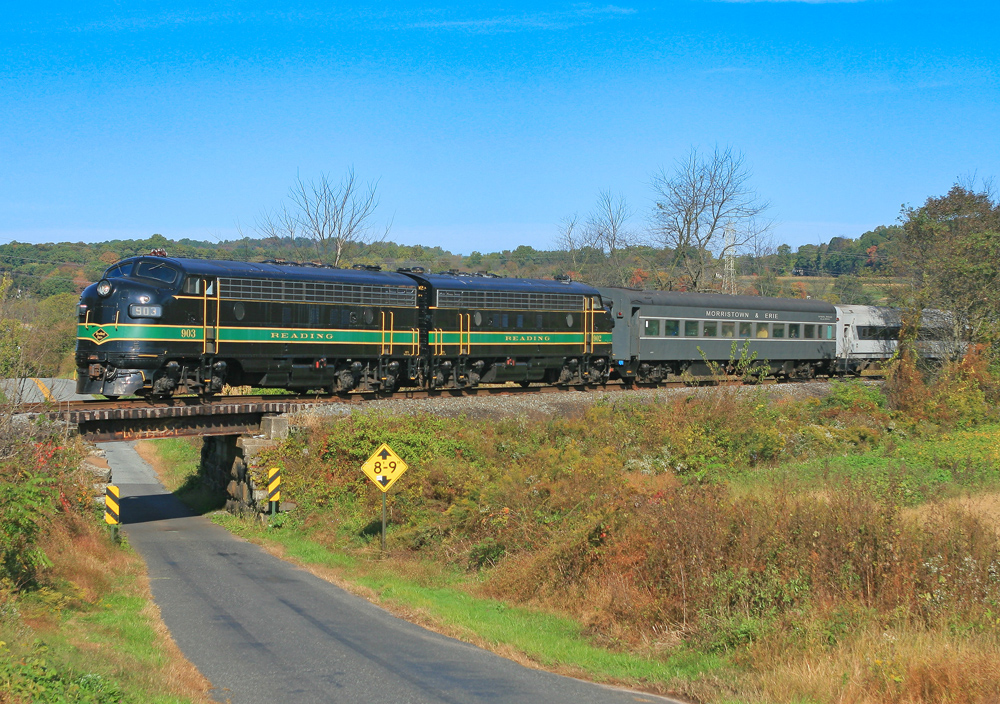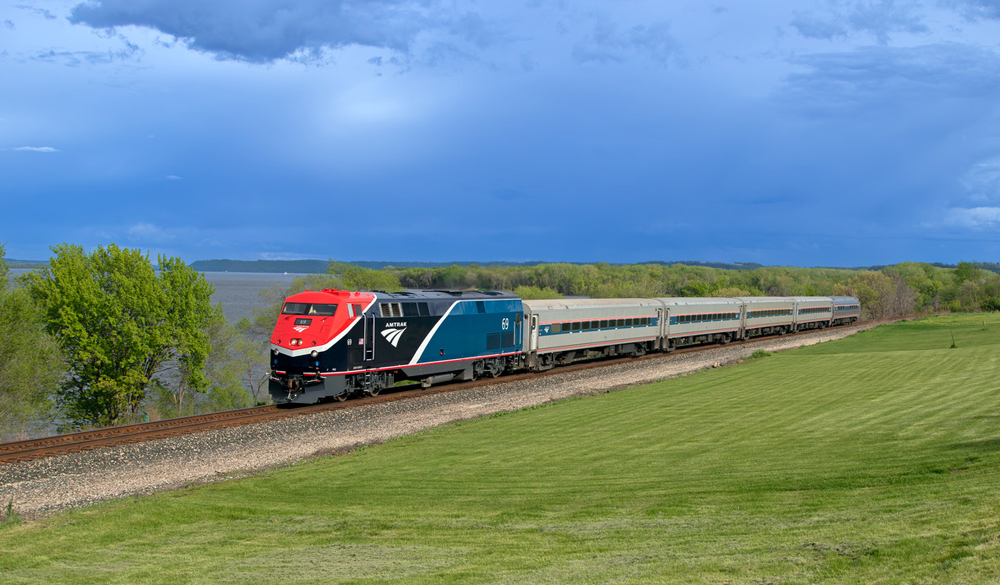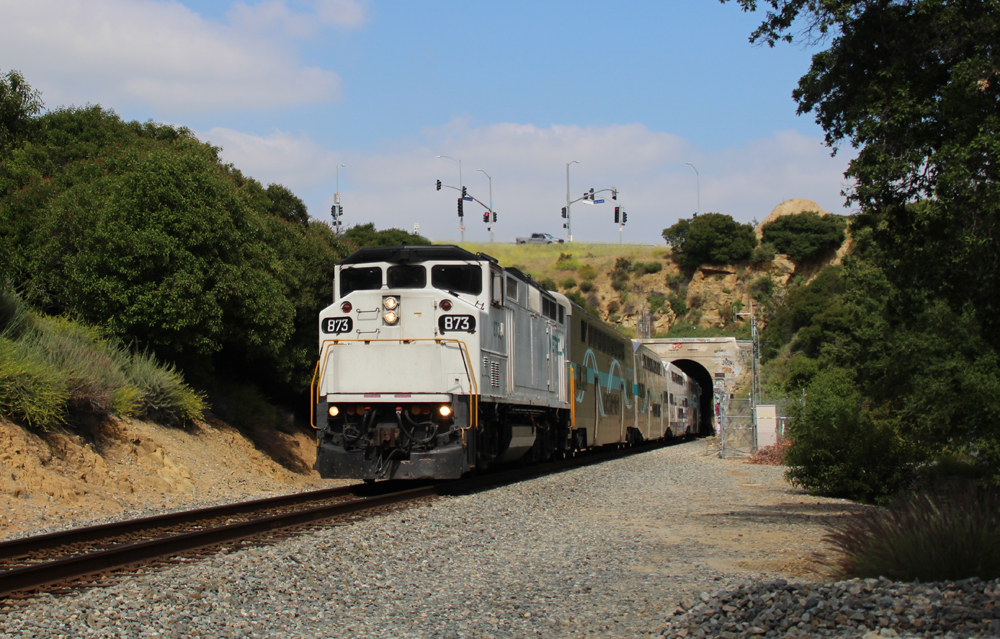
PHILADELPHIA – The Philadelphia Chapter of the National Railway Historical Society has sold former Reading Co. FP7 No. 903 to SMS Rail Lines for use on their Woodstown Central tourist railroad in New Jersey. No. 903 and sister 902, owned by the Reading Co. Technical & Historical Society, have been stored at Steamtown in Scranton, Pa., since 2010.
According the Philadelphia Chapter’s newsletter, early in 2023 the Chapter was approached by SMS to lease No. 903 for a ten-year period. In July the Philadelphia Chapter board considered the proposal and decided to sell rather than lease the engine to SMS at a cost of $10,000. SMS also hopes to lease or acquire No. 902.
Reading Nos. 902 and 903 were among the first six EMD FP7s ordered by the railroad in March 1950 to replace passenger steam locomotives. The two units were completed on June 1, 1950 and delivered to the Reading. They remained in SEPTA commuter service until 1981.
In 1983, both locomotives were purchased by NRHS chapters. No. 902 was obtained by the Lancaster (Pa.) Chapter, while 903 was purchased by the Philadelphia Chapter. They were stored at the Railroad Museum of Pennsylvania in Strasburg. Restoration of the FP7s began in 1986 and was completed in 1995. In 2007, the Lancaster Chapter donated the 902 to the the Reading Co. Technical & Historical Society.














Yes, the caption is incorrect: there are three RDG FP7’s while the caption says two.
The Push-Pull FP7’s had received cab signals to operate into PRR’s Newark NJ Station under the 1967 Aldene Plan.
In preservation they operated fantrips over SEPTA routes. One of the most interesting trips was to East Strasburg from 30th St. Upper Level via the Amtrak crossover at Leaman Place. The GG1 trips from Wash always had the passengers change trains at Leaman Place, but the 902-903 pulled the Bombardier commuter coaches by themselves, with a Republic RL-1 providing HEP and serving as a cab car on the PRR end.
While they were still in push pull service the Reading ran a circle trip out of reading up the East Penn to Bethlehem, then down to Wayne Jct. From there we took the freight line on the west side of the river through Abrams yard and back to Reading. An all day trip. I still have the trip booklet provided that day.
Glad to see that someone corrected the “only two” remark in the article. 900 has been in storage for so long that many don’t even know it still exists. There was talk that the 902 would be leased to SMS but there has been backtracking on that. A lease could get the RCT&HS some
monies for 900’s long awaited return. Plus the engine is stranded in Scranton, with the 903, where it doesn’t belong. There can’t be a better way to move it than to get a sympathetic operator that is also expert at repairs and restoration, who can get it closer to home. Philadelphia and Reading were their home
towns, after all, and Woodstown, NJ is in the Philly region, on a PRSL branch.
Does that $10,000 sound like a low price for this?
There were eight FP7’s, 900-905 built in 1950 with 89 mph gearing, no dynamics and EP brakestands to work the Crusader and other NY trains on the NY Branch (speed limit 85 until ICC required cab signals, 75 after that). 906-907 came in 1952 with no EP brakes, otherwise the same.
In about 1965 RDG manufactured a push-pull train by installing MU cables on the roofs of 5 2000-series reclining seat coaches and deluxe coach 1547. There was no cab car; instead RDG ran an FP7 at each end of the train. 900, 902 and 903 were retained for this train while the rest of the FP7’s were retired.
Soon, RDG’s service beyond the wires was handled by 16 RDC’s and the Push-Pull.
When ConRail came in, the train flowed eventually to SEPTA which discontinued all diesel service when the Center City Tunnel went into service.
The sleek EMD FP7 is a 1,500 horsepower (1,100 kW), B-B dual-service passenger and freight-hauling diesel locomotive produced between June 1949 and December 1953 by General Motors’ Electro-Motive Division and General Motors Diesel. Final assembly was at GM-EMD’s La Grange, Illinois plant, excepting locomotives destined for Canada, in which case final assembly was at GMD’s plant in London, Ontario. The FP7 was essentially EMD’s F7A locomotive extended by four feet to give greater water capacity for the steam generator for heating passenger trains.
Dr. Güntürk Üstün
In the context of the fantastic EMD FP7, this Pennsylvania’s loss is New Jersey’s gain.
Dr. Güntürk Üstün
Reading Company FP7 900 is also preserved by the Reading Co. Technical & Historical Society at the Reading Railroad Heritage Museum in Hamburg PA, ironically on the ex-PRR Schuylkill Division.
That’s right. Built between 1950-1952.
Dr. Güntürk Üstün